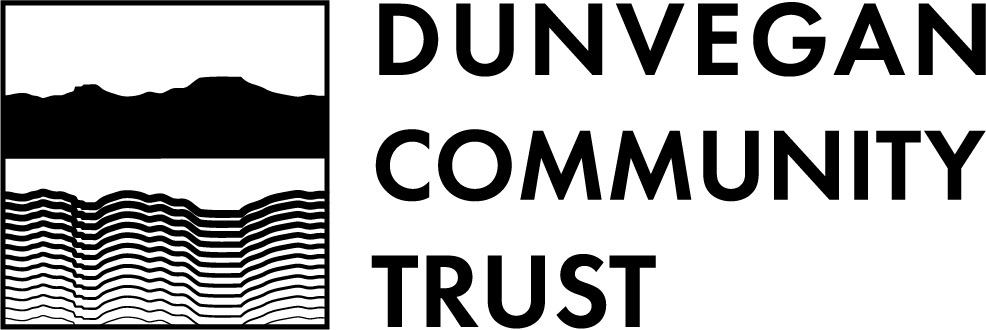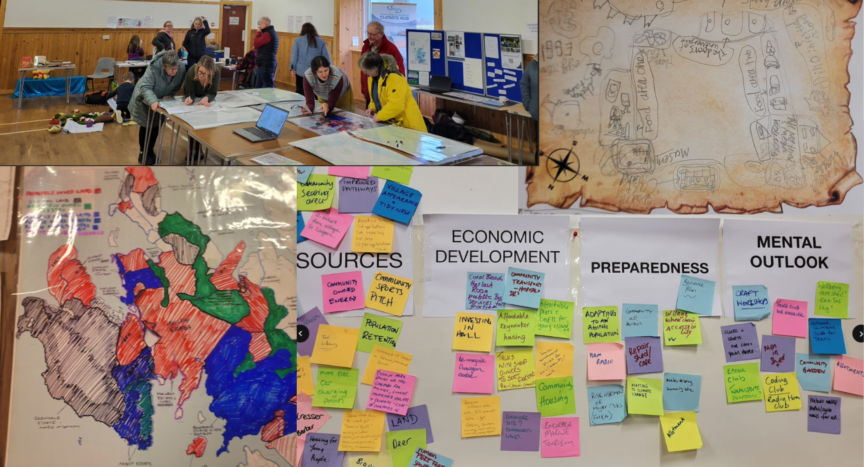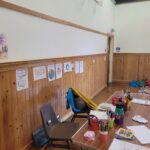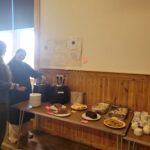1st May 2025
We held our Survey Reporting event on the 26th of April to share the findings of the surveys. We received 130 responses from Dunvegan Community Council (DCC) Area residents, and you can view that Survey Report HERE.
We also received 73 responses to the Survey for those who live outwith the DCC area. You can view that Survey Report HERE.
We had some comments at the event on the interpretations of the data and suggestions for how some aspects can be displayed in different ways. Please read over the reports and give any suggestions or feedback you have – email us or you can also arrange a time to have a chat if you would prefer! We will be emailing the Report findings to our members in manageable chunks over the next few weeks by topic. It’s important to note that these documents are NOT the final action plan – they are just reporting on the Survey data, which will contribute to the final plan.
We also held the prize draw – we had 1 winner from online survey and 2 winners who completed paper surveys. If you have a winning raffle ticket – we’re looking for numbers 42 and 107 – please email or message us with a photo of your ticket! dunvegancommunitytrust@gmail.com
20th March 2025 :
In 2024 Dunvegan Community Trust began the planning for the development of a Community Action Plan (CAP). From ‘Community Action Plans : An Approach to Place Based Strategic Planning’,
Scottish Community Alliance September 2020:
“Community led action planning is a tried and tested way of setting outa vision for a community with an accompanying set of actions to be
delivered over time. It is a participatory tool aimed at not only developing that plan, but, in the process, building the capacity of the residents of a community so
that there is the skills, confidence, resources and resilience to implement that plan with minimal external support. It is not meant to articulate what a community is like, but to stimulate
change and action. The action plan will be set out in response to the needs, challenges and gaps in a community and the implementation plan will be rooted in the assets of a community. Under an aspirational statement about what people want the community to be like in an achievable future, there is detail about what will be done, who will do it, how it will be resourced and how it will be
undertaken. It is often led by one group, (often an over-arching community anchor organisation, development trust or community council) but delivery is the responsibility of the whole community and not that one organisation. As a result, a good plan will see existing organisations stepping up to the plate, and new organisations forming.”
Another element of community planning can be the development of a Local Place Plan (LPP). From the same document: “In 2017 The Scottish Government introduced the Planning
(Scotland) Bill. The Bill introduces a new right for communities to produce Local Place Plans. The objective of a Local Place Plan is to “significantly enhance engagement in development planning, effectively empowering communities to play a proactive role in defining the future of their place”. Spatial or ‘development planning’ includes things like housing, public facilities, business growth, use of land or buildings, roads, flooding, energy, recreation, paths and other infrastructure which impact on people. A good plan should ideally merge these approaches, containing both community consultation and project development, but also a vision for the physical place using design techniques.”
(The document can be read in full here.)
There isn’t any one way to produce a CAP, and every CAP is different, as you can see by looking at other groups plans, linked below, but as we’re keen to not have to duplicate work (and increase expense) , we set out to tackle the CAP in a way which would allow it to be developed into an LPP (if that indeed is what the community wants).
Link to Struan Community Action Plan
Link to Localsh Community Action Plan
Applecross Community Action Plan
Raasay Climate Change Action Plan
Initially we had conversations with Planning Aid Scotland and Community Enterprise, who offer both free support and paid consultancy work to communities who perhaps don’t have the capacity to manage the production of a plan ‘in house’, or at least ‘in community’. Community Enterprise displayed a huge degree of flexibility in their approach – they could tell us the services they provide, what they can offer for free and what would be paid, so that we could pick and choose what we wanted to do ourselves, and what we needed help with. They could also step in with paid services ad-hoc if we came up against insurmountable obstacles or just got overwhelmed with the work. In the end we have opted for very little outside consultancy – we have engaged a researcher/consultant from NW Skye, Dr Liza Cleland, who has a deep knowledge of the area, the challenges, and what changes have occurred over the last 40 years. We received £5000 in Community Regeneration Funding in September 2024 to launch the first phase of the project, which covered hall fees for 13 face to face events, 3 hours per week staff costs for Project management, half of the consultant fees and some printing costs. The funding takes us up to the gathering of all the surveys responses, roughly half way to the production of the final plan. The super-local approach so far has paid off in several ways- we’re not sending funding outside of the DCC area, we’re getting an almost unquantifiable amount more for that £5000 by having a consultant who already knows the area, and our community survey was much more in-depth than the stock survey produced by outside consultants. The engagement level has also been exceptional, with over 200 people involved through face to face events, and a fantastic response to the survey, despite it being 3 times longer than the stock surveys. We had 130 adult responses from the Dunvegan Community Council area, approx 40% of our households (% lowered to account for some multiple responses per households). We also had 70 adult responses from outwith the DCC area, and around 50 (so far) teens and kids from across NW Skye. 200 overall is at least 30% of the c.625 households in north west Skye (also lowered for multiple responses per household). In any surveying, response rates of 25% are considered excellent, so we now have brilliant evidence for local needs and engagement.
Some of Liza’s preliminary research can be read below:
Comment on Housing Need Survey
NEXT STEPS:
A Survey Reporting Event will be held in April to display the findings of the survey. The prize draw will also be conducted at this event! Date TBC






